As the name suggests, red mushrooms are characterized by reddish hues. The shade of red can be from bright and vibrant red to more subdued or deep crimson. Red mushrooms have cap shape that can be convex, flattened, or even irregular in form. Some may have a wavy or contorted appearance.
The gills, pores, or spore-bearing surfaces underneath the cap may be white, cream or yellow. The stem of red mushrooms can be solid or hollow and can share the same color as the cap or can be somehow lighter. Their spore print can be white, cream, pink or even a pale in color.
They commonly found in forests and woodlands, where they form symbiotic relationships with trees, or amidst grasslands and meadows. They can equally be present at home in urban environments or in parks, gardens and even lawns. Some species can be found growing on decaying wood (fallen branches and rotting tree stumps) while others find their habitat in high-elevation alpine and subalpine areas.
Red Mushrooms are found everywhere around the world from Australia, Asia, Africa, Europe, South America to North America. Even in the extreme conditions of Antarctica, some red mushrooms, have been discovered in soil and plant material.
Some red mushrooms are edible and can be added to soups, stews, sautés, risottos etc. while others are notorious for being toxic or potentially deadly. Nevertheless, as a general rule, anyone interested in foraging for wild mushrooms should be extremely cautious and seek expert guidance, use reliable field guides or rely on local knowledge.
List of Red Mushrooms
- Amanita muscaria – Fly agaric
- Laccaria bicolor – The deceiver
- Russula emetica – The sickener
- Hygrocybe punicea – Crimson waxcap
- Sarcoscypha coccinea – Scarlet elf cup
- Leccinum aurantiacum – Red-capped scaber stalk
- Tricholomopsis rutilans – Plums and custard
- Mycena haematopus – Bleeding fairy helmet
- Xerocomellus chrysenteron – Red cracking bolete
- Boletus bicolor – Two-colored bolete
- Ringless False Fly Amanita Mushroom (Amanita parcivolvata)
- Basket Stinkhorn Mushroom (Clathrus ruber)
- Octopus Stinkhorn Mushroom (Clathrus archeri)
- Jackson’s Slender Amanita Mushroom (Amanita jacksonii)
- Stinky Squid Mushroom (Pseudocolus fusiformis)
- Ox Tongue Mushroom (Fistulina Hepatica)
- Frost’s Bolete Mushroom (Butyriboletus frostii)
- Poison Fire Coral (Podostroma cornu-damae)
- Cortinarius sanguineus (Blood-red webcap)
- Hygrophorus miniatus (Vermilion waxy cap)
Description and Facts About Red Mushrooms
Amanita muscaria – Fly agaric

The cap of Amanita muscaria is bright red, although it can have orange or yellow hues. It is usually covered in white to yellowish warts or spots. The cap is convex when young, later flattening out, and can reach diameters of 8 to 20 centimeters.
The white, free gills are crowded and sometimes have an adnate attachment to the stem. The stem is usually white, sometimes with remnants of the universal veil as a white ring or collar around the upper part. It is 10 to 20 centimeters long, although it can be shorter or longer.
Amanita muscaria is considered poisonous. It contains toxic compounds like muscimol and ibotenic acid. Ingesting this mushroom can lead to nausea, vomiting, hallucinations, delirium and in severe cases, seizures and even death.
Usually recurring in the same place for several years, Amanita muscaria is found frequently throughout the northern hemisphere, including Britain and Ireland, mainland Europe, Asia, the USA and Canada.
Laccaria bicolor – The deceiver

The cap of Laccaria bicolor is 2 to 5 centimeters in diameter and is characterized by its two-tone coloration. It is usually reddish-brown to orange-brown with a paler margin. The cap is convex and becomes flatter with age. It may become flat with a central depression or navel.
The gills underneath the cap are closely spaced, white, and have a decurrent attachment to the stem. The white spore print is a notable characteristic. The stem is slender and usually a similar color to the cap, sometimes with a paler base. It ranges from 4 to 8 centimeters in length. The stem also has fine, thread-like fibers or striations on its surface.
The mushroom’s flesh is whitish but may be tinged with pink or ochraceous hues. It doesn’t possess a smell or taste.
Laccaria bicolor grows in mixed birch and pine woods. It is found in the temperate zones of the globe. It fruits in the late summer and fall, generally from late August to November especially in Europe and North America.
The Bicoloured Deceiver Laccaria bicoloris an edible mushroom. The caps can be sautéed or pan-fried in butter or oil and included in stir-fry dishes, soups and stews. The caps can also be used as a pizza topping along with other ingredients like cheese, sauce and vegetables.
Also Read: Different Types of Green Mushrooms
Russula emetica – The sickener

Russula emetic is also commonly referred to as the sickener, emetic russula, or vomiting russula.
The cap of this mushroom is between 2.5 to 8.5 cm (1.0 to 3.3 inches) in diameter with convex to flat shape and bright red to reddish-pink color. It is sometimes with a central depression or a shallow umbo.
At maturity, the cap has fine radial grooves extending towards the center. The cap’s cuticle can be easily peeled from the cap almost to the center. The brittle flesh is white, or it may have a red tinge directly under the cap cuticle.
The gills are closely spaced, white to creamy-white, and may be adnate (completely attached), adnexed (attached at an angle) or completely free. Occasionally, the gills near the cap margin may be forked. There are also cross-veins in the spaces between the gills.
The stem is white and cylindrical, with no ring or veil. It can range from 5 to 10 cm (2 to 4 inches) in height. The stem can be either stuffed (filled with a cottony pith) or partially hollow. The mushroom in general produces a white to yellowish-white spore print.
As its name implies, the sickener is inedible. It is toxic and should never be consumed. Most of the time this mushroom can easily be confused with other red-capped Russula species, some of which are edible.
Hygrocybe punicea – Crimson waxcap

The cap of Hygrocybe punicea is convex to broadly umbonate when young, and becomes flat as it matures. It can reach sizes of up to 150 mm (6 inches) in diameter. The cap’s surface is smooth but becomes greasy and viscid (sticky) when moist. Initially, it is dark red to crimson, and as it dries, it may change to a pale yellow to buff color in some areas.
The gills are waxy in texture and are dark red to buff with purple tints. They may have a yellowish margin. The stem is smooth but may have fibrils (fine fibers) and streaks. It is yellow to orange-red, transitioning to whitish toward the base. This stem lacks the presence of a ring or annulus. The spore print is white.
The Crimson Waxcap is commonly found in grassy areas, meadows and pastures, usually in close proximity to trees. This mushroom is widespread in North America and many regions of the world. It is particularly rare throughout Europe.
Sarcoscypha coccinea – Scarlet elf cup
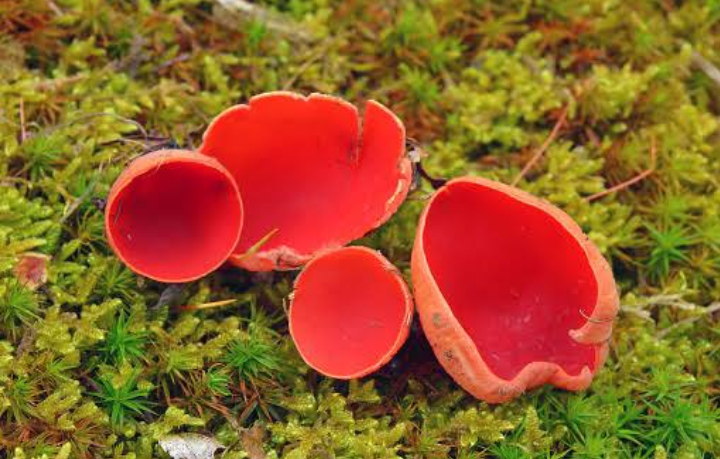
The fruit bodies of Sarcoscypha coccinea start as spherical structures and later develop into shallow saucer- or cup-shaped forms with rolled-in rims. These cups measure between 2 to 6 centimeters (0.8 to 2.4 inches) in diameter.
The inner surface of the cup is deep red, although it can fade to an orange hue when dry. The outer surface is covered with a mat of tiny hairs, creating a tomentum.
If a stipe is present, it is usually stout and can be up to 4 centimeters (1.6 inches) in length. The stipe, like the outer surface of the cup, is also covered in a tomentum.
This mushroom is found on decaying wood, such as fallen branches, rotting logs, and deadwood, especially hardwood trees like beech, oak or hornbeam. They can also appear on other woody debris or buried wood.
The mushroom, widely distributed in the Northern Hemisphere, has been found in Africa, Asia, Europe, North and South America and Australia. The mushroom seen in late winter to early spring when other fungal species are less active.
Also Read: Different Types of Orange Mushrooms
Leccinum aurantiacum – Red-capped scaber stalk
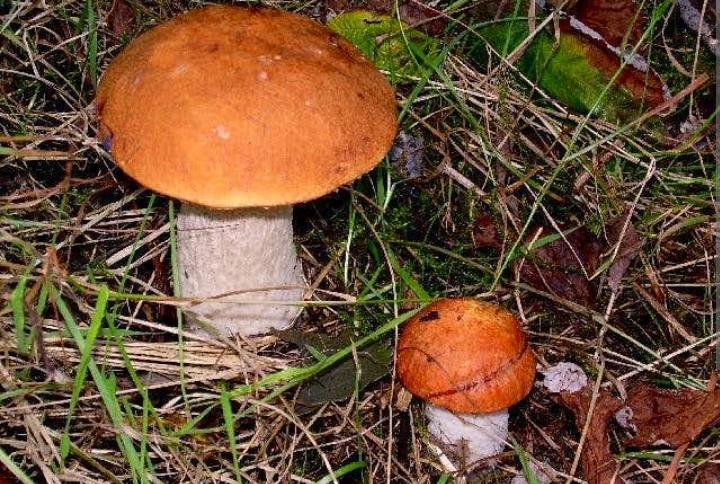
The cap is convex when young and becomes flatter with age. The cap is about 5-20 centimeters (2-8 inches) in diameter. It is bright orange to red, occasionally fading to a paler orange or yellow as it matures. The surface is usually dry and somewhat scaly, with fine scales or spots.
When the cap is bruised or damaged, it undergoes a color change, initially turning burgundy and then progressing to grayish or purple-black. This color-changing aspect can be the major identifying feature of this mushroom.
Instead of having gills like many mushrooms, the underside of the cap of this mushroom has small, whitish pores. These pores bruise olive-brown when touched, cut or bruised.
The stem is usually sturdy, cylindrical and swollen in the middle. It can reach heights of 5-15 centimeters (2-6 inches) and is covered in a network-like pattern that look-like a reticulation. The stem’s color is usually pale to light brown. This species is edible.
This mushroom is found in forests of Eurasia and North America. It is most commonly associated with hardwood trees, especially birch and aspen, but it can also be found near conifers such as pine, spruce and fir. In North America, it is sometimes referred to by the common name red-capped scaber stalk.
Tricholomopsis rutilans – Plums and custard

Tricholomopsis rutilans, commonly known as plums and custard, or red-haired agaric, is a species of gilled mushroom found across Europe and North America. Plums and Custard takes its common name from its plum-red scaled cap and crowded custard yellow gills.
The cap of this mushroom starts as convex and gradually changes to bell-shaped before flattening with age. It about 1-5 inches in width and has an incurved margin when young. The cap is covered with red to purplish-red or brick-red hairs.
As the mushroom matures, these hairs tend to clump together into small scales. Beneath the red or purplish-red surface, the color of the cap transitions to yellow.
The gills are attached to the stem, crowded, and have an adnate to somehow decurrent attachment. They are pale yellow when young but can turn rusty brown as the mushroom matures.
The stem is about 4-10 cm (1.6-4 inches) tall. It is similar in color to the cap, with a reddish-brown to purple-brown pattern near the base. The stem may or may not have a ring. The spores of this mushroom are cream-colored.
Plums and Custard mushrooms are saprobic, meaning they derive their nutrients by decomposing well-decayed wood. They are widely distributed across North America. These mushrooms can grow alone, scattered, or gregariously (in clusters).
Other than natural forest environments, these mushrooms are occasionally reported to grow in woodchips, sawdust, and lignin-rich soil.
Mycena haematopus – Bleeding fairy helmet

The cap of this mushroom undergoes changes in shape as it matures. It begins as ovoid or conical when young, becomes campanulate (bell-shaped) in the middle stages of development, and eventually flattens out with an umbo (a central nipple-shaped bump) when fully grown.
The cap can reach a diameter of up to 4 cm when mature. Initially, it appears dry and has a whitish powder-like covering, which later becomes polished and moist. The cap’s color is reddish- or pinkish-brown, sometimes with hints of violet, and it is paler toward the edges.
The mushroom’s flesh can be pale or a vinaceous color, almost like red wine, and it doesn’t have any smell. When the flesh is cut, bruised or injured it oozes a red latex that oozes.
The gills have an adnate attachment to the stem. At the start, they are whitish or “grayish vinaceous” in color but can develop reddish-brown stains.
The stem can reach heights of up to 9 cm. It is hollow and brittle and is dark reddish-brown in color. In young specimens, the upper part of the stem is covered with a pale cinnamon-colored powder that wears off as the mushroom ages.
Mycena haematopus is a saprophytic fungus. It is commonly found growing on rotting wood, such as fallen logs and decaying branches and sometimes on leaf litter. It tends to fruit during the late summer and fall months.
Xerocomellus chrysenteron – Red cracking bolete

Young mushrooms usually have a dark, dry surface and caps covered in tomentum. As they mature, the caps expand and become brownish.
The cap flesh is thin and has very little substance. It turns blue when cut or bruised. At maturity, the caps become convex and then flat, revealing a thin layer of light red flesh below the skin through the cracks that form.
This mushroom does not have gills. Instead, it has a porous surface on the underside of the cap, with small, angular pores. The spore print of this mushroom is olive-brown which is unusual for boletes.
The stem is cylindrical, 4-10 centimeters (1.6-4 inches) in height. It is the same color as the cap, although the base may have more red or brown hues. The stem may also have a fine network pattern. The stem flesh is cream-colored and turns blue when cut or damaged. This mushroom is edible.
The Red Cracking Bolete can be found in parts of Europe, Asia, Africa and North America. It tends to prefer well-drained soil, in areas with decaying organic matter, such as leaf litter and rotting wood. It fruits during late summer and throughout the autumn.
Boletus bicolor – Two-colored bolete

Baorangia bicolor, also known as the two-colored bolete or red and yellow bolete. It is named after its two-tone coloring scheme of red and yellow.
The cap of Boletus bicolor is 6-15 centimeters (2.4-5.9 inches) in diameter. It is convex when young but flattens out and may develop a slight depression in the center as it matures. The cap’s color can be light red and almost pink to brick red, with the most common color being brick red when mature.
Instead of true gills, this mushroom has a porous underside with a network of fine, angular pores that are yellow when young and gradually turn green as the mushroom matures. The pore surface can bruise dark blue or indigo when injured.
The stem of this mushroom is usually 6-15 centimeters (2.4-5.9 inches) tall. It is generally cylindrical, sturdy, and has a reddish-brown to brown color. There is no ring or skirt around the stem.
Generally, the flesh of this bolete is pale yellow and turns blue when cut or bruised, especially in the cap and stem. The spore print is green.
This mushroom is edible. It inhabits most of eastern North America, primarily east of the Rocky Mountains and in season during the summer and fall months but can be found across the globe in China and Nepal.
Amanita parcivolvata – Ringless False Fly Amanita Mushroom

The cap of Amanita parcivolvata is bright red and about 3 to 12 cm (1.2 to 4.7 inches) in diameter. The cap surface may have warts, which are pale yellow to white in color. These warts can sometimes be washed off by rain, which can give the cap a resemblance to other Amanita species.
The gills of this mushroom are white to pale yellow. They are closely spaced, free from the stem (stipe), and sometimes have a serrated or fringed margin.
The stem is about 3 to 12 cm (1.2 to 4.7 inches) in length. It features pale yellow to white powdery volval remnants all along the stipe. The volva, which is the cup-like structure at the base of the stem, is rather undeveloped compared to other Amanita species.
This mushroom is common in states within the southeastern United States, such as parts of Alabama, Georgia, Florida, South Carolina and other neighboring regions. It starts appearing as early as late summer, that is, from July to September.
Clathrus ruber – Basket Stinkhorn Mushroom
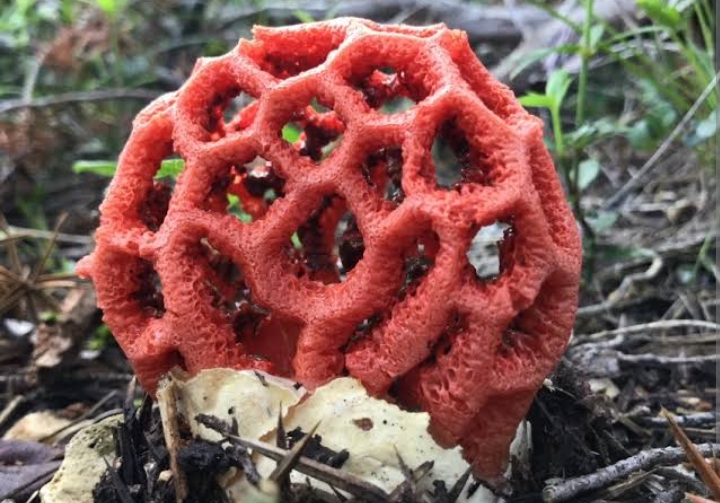
It is commonly known as the latticed stinkhorn, the basket stinkhorn, or the red cage.
The fruiting body of Clathrus ruber starts as an egg-shaped structure, usually buried in the ground. As it matures, it bursts open, revealing a lattice-like structure that resembles a red or orange basket. This lattice-like structure is where the common name “Basket Stinkhorn” comes from. The inside of the basket is covered with a slimy, foul-smelling mass, which contains the spores.
Basket stinkhorn can be found in countries and regions within the tropics and subtropics like parts of Asia, Africa, South America and the southern United States. It grows on the forest floor, in gardens or in mulched areas. It prefers places with decaying organic matter.
Because of its strong, unpleasant odor and slimy texture, this mushroom is not edible.
Clathrus archeri – Octopus Stinkhorn Mushroom

It is commonly known as octopus stinkhorn or devil’s fingers. At the beginning, it erupts from the ground as an “egg,” which is about the size of a chicken egg.
As the fungus matures, the egg-shaped structure ruptures to reveal several reddish-orange to pinkish arms or tentacle-like structures. These arms radiate outwards, giving it the appearance of an octopus or a hand.
The arms are connected at the base and have a lattice-like or cage-like structure, giving rise to the genus name “Clathrus,” which means “lattice.”
The arms are hollow, and their surface is covered in a slimy, foul-smelling, olive-green spore-bearing substance. The odor is often described as similar to (putrid flesh) rotting meat, hence the common name “stinkhorn.”
It is native to Australia and New Zealand, but it has been introduced to other parts of the world, including Europe, Asia, and North America, through the movement of contaminated soil and plant material.
Amanita jacksonii – Jackson’s Slender Amanita Mushroom
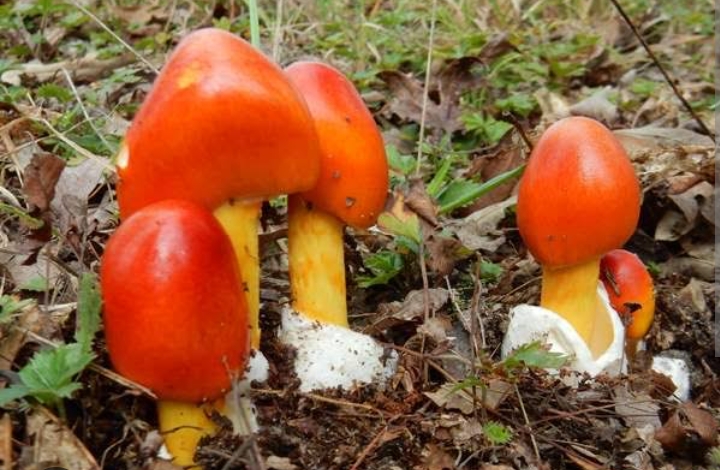
Amanita jacksonii is also referred to as Jackson’s slender amanita, American Slender Caesar and Eastern Caesar’s Amanita.
The cap of Amanita jacksonii is about 4-10 cm (1.5-4 inches) in diameter. It is initially egg-shaped but becomes convex and then flat with maturity. The cap’s color is usually bright orange-red or reddish-brown, with a somehow paler center and striations along the margin.
The gills are white and free from the stem, meaning they do not attach directly to it. The stem is slender, measuring 7-15 cm (2.75-6 inches) in height. It is white, sometimes with small remnants of the universal veil at the base.
Amanita jacksonii usually has a fragile, white ring, which is the remnant of the partial veil that initially covers the gills. It also has a volva (a cup-like structure at the base of the stem) which is mostly buried in the soil. The volva is white to pale orange and may have warts or patches of the universal veil on its surface.
It is widespread throughout North America, especially in the eastern United States, though it can also be found in other regions of the continent. The mushrooms appear in the summer and early fall, usually growing in clusters.
Pseudocolus fusiformis – Stinky Squid Mushroom
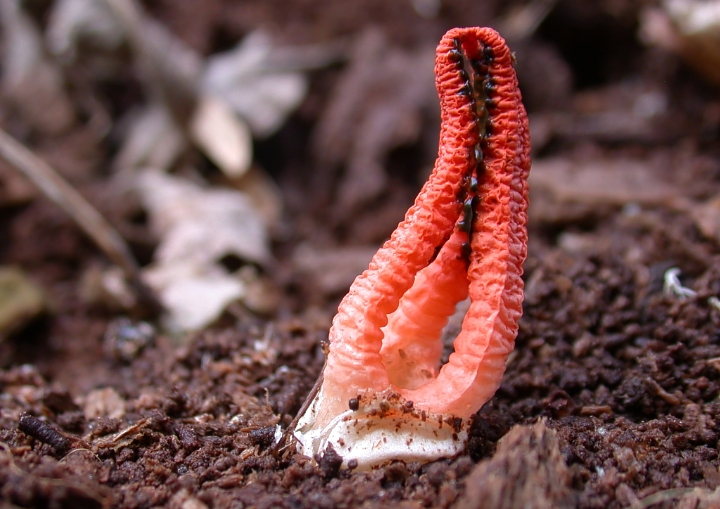
It is commonly known as the stinky squid, because of its fetid odor, and its three or four upright “arms” which are connected at the top. When young this mushroom resembles egg- or pear-shaped puffballs. These young fruiting bodies are grayish-brown to pale gray.
As the fungus matures the puffball-like structure cracks. From the cracked open structure, a stalk forms, which gives rise to tapering arms which are 2 to 5 times the length of the stipe. The arms are chambered, with one large chamber toward the outside and typically three smaller chambers on the inside of each arm.
The inside faces of the arms are covered by dark greenish slimy substance called gleba. The gleba emits a fetid odor, like “fresh pig manure,” which serves to attract insects for spore dispersal.
The stipe (stalk) does not extend past the volva (cup-like base). It is hollow, thin-walled, chambered, wrinkled, and flares towards the upper end. The stipe is white or grayish-white.
This mushroom is widespread and has been found in the United States, Australia, Japan, Java, Africa and the Philippines.
Fistulina Hepatica – Ox Tongue Mushroom

Fistulina hepatica gets its common name, “Ox Tongue Mushroom,” from its appearance. It resembles a slab of raw meat or the tongue of a large animal, like an ox. The cap of the mushroom is broad and flat, reaching up to 20 cm in diameter. It can be reddish-brown, brown, or sometimes orangish on the upper surface, with a smooth texture.
The underside of the cap is covered with tiny pores instead of gills, which release spores. These pores have a similar color to the cap, and when injured, they release a red, blood-like juice, and thus sometimes called “Beefsteak Fungus.”
Ox Tongue Mushroom is a parasitic mushroom. It majorly grows on living hardwood trees like oaks, beeches and chestnuts. It is commonly found in parts of the world like North America, Europe, Africa, Asia and Southern Africa.
This mushroom is edible. It has been used as a meat substitute in the past, and can still be found in some French markets. It has a sour, slightly acidic taste. For eating it must be collected young and it may be tough and need long cooking.
Butyriboletus frostii – Frost’s Bolete Mushroom

The cap of Frost’s Bolete is medium-sized, with a diameter of about 5 to 15 cm (2 to 6 inches). The cap’s color can be reddish brown to dark chestnut. It is convex when young, but it eventually flattens out as it matures.
The underside of the cap, there are no gills but rather spore-producing structures. These pores are white when the mushroom is young but turn yellow as it ages. When injured or touched, the pore surface may turn blue or green. Young mushrooms have a whitish bloom on the cap surface.
In moist conditions, the cap surface is sticky. If the fruit body has dried out after a rain, the cap is especially shiny,sometimes appearing finely areolate (having a pattern of block-like areas similar to cracked, dried mud)
The stem is stout about 6 to 12 cm (2.4 to 4.7 inches) in height. It is bulbous at the base and gradually tapers upwards. The stem is covered with a net-like pattern or a mesh-like structure. The spore print is brown. The flesh is pale yellow or lemon yellow and firm. The flesh does not change color when cut.
This mushroom is nonpoisonous though it is usually viewed with suspicion because of its red hymenium. It is distributed in the eastern United States from Maine to Georgia, and in the southwest from Arizona extending south to Mexico and Costa Rica. It is also found in parts of Africa and Asia.
Podostroma cornu-damae – Poison Fire Coral

The fruiting body commonly referred to as the “coral,” looks like branching coral colonies. The branches are finger-like projections coming out from a central point. These branches can be reddish-orange, pinkish-red or occasionally brownish in color.
The size of individual fruiting bodies can be from a few centimeters to around 10-20 cm (4-8 inches) in height. The surface is smooth and may feel slimy to the touch.
The Poison Fire Coral is considered one of the most toxic fungi in the world. It is commonly found in subtropical and tropical regions, including parts of Asia like Japan and China. It grows in forested environments and usually on the ground with decaying plant matter, dead wood or leaf litter.
Blood-red webcap – Cortinarius sanguineus

The cap of Blood-red webcap is initially dark blood-red, convex, and about 2–5 cm (0.8–2 inches) in diameter. As it matures, the cap flattens, and its surface is covered in silky fibres radiating from the center. The stipe (stem) is usually the same color as the cap or paler and about 3–6 cm in height.
The gills of this mushroom are attached to the stem at their lower end. When young, the gills are of blood-red color. However, as the mushroom ages and the spores mature, the gills tend to turn reddish brown. When a spore print is taken from this mushroom it is rust-colored. The spores themselves are oval.
This mushroom grows in conifer woodlands, commonly appearing in the autumn season. It is also considered edible. The flesh is purple-red and is said to have a pleasant smell.
Vermilion waxy cap – Hygrophorus miniatus
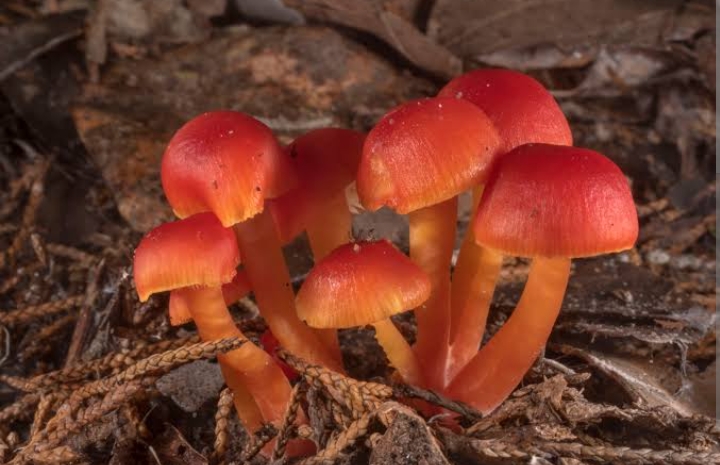
Hygrocybe miniata, commonly known as the vermilion waxcap or miniature waxy cap, is a small, bright red or red-orange mushroom. It is a cosmopolitan species, that is found worldwide.
In Europe, it is found in fields, on sandy heaths, or grassy commons in the autumn. It is found in rainforest and eucalypt forest as well as heathland in Australia.
The cap starts out convex but later flattens and becomes depressed, with wavy edges. Mature fruiting bodies have a noticeably scurfy or scaly center. The cap is scarlet-orange with a yellow striate margin.
Cap diameter is about 0.5 to 3.5 cm. The gills are orange or red and have adnate attachment to the stem. The cap’s bright red, orange, or vermilion is what gives it the common name “vermilion waxcap.”
The stem is long, possibly up to three times the diameter of the cap, and it tapers toward the base. The stem is either the same color as the cap or somehow paler, with a white base.
The flesh is orange and is devoid of any odor. The spore print is white. Though its edibility is unclear, it is considered nonpoisonous.